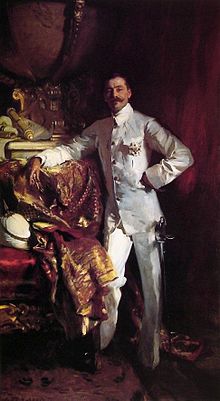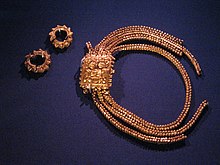National Treasures of Singapore
The national treasures of Singapore are artifacts deemed to have significant historical importance to the country of Singapore.
List[edit]
Below is a list of artifacts considered to be National Treasures by the National Museum of Singapore.[1]
| S/N | Name | Description | Year | Image | Ref |
|---|---|---|---|---|---|
| 1 | Singapore Stone | The Singapore Stone is a fragment of a large sandstone slab which originally stood at the mouth of the Singapore River, believed to date back to at least the 13th century and possibly as earlier. | Unknown | 
|
[1][2] |
| 2 | Portrait of Sir Frank Athelstane Swettenham | Portrait of the first Resident General of the Federated Malay States, by John Singer Sargent | 1904 | 
|
[1][2] |
| 3 | Last will and testament of Munshi Abdullah | Munshi Abdullah is widely considered as the father of modern Malay literature and was scribe and copyist for Sir Stamford Raffles. | 1854 | [1] | |
| 4 | Mace of the City of Singapore | Chinese philanthropist Loke Wan Tho in conjunction with King George VI granting Singapore a Royal Charter in 1951 | 1951 | [1] | |
| 5 | Daguerreotype view from Fort Canning Hill | By French customs service officer Alphonse-Eugene Jules | 1844 | [1] | |
| 6 | Gold armlets and rings from Fort Canning | East Javanese style, found at Fort Canning Hill | 1928 | 
|
[1] |
| 7 | Portrait of Sir Stamford Raffles | Portrait of the founder of Singapore by noted painter Xu Beihong | 1939 | [1] | |
| 8 | Natural history drawings of flora and fauna | Collection of 477 drawings commissioned by William Farquhar | 19th century | 
|
[1] |
| 9 | A wooden hearse | Used for the funeral of Chinese philanthropist Tan Jiak Kim | 1917 | [1] | |
| 10 | Embroidered Chinese coffin cover | One of the largest of its kind in existence in Singapore | unknown | [1] | |
| 11 | A glove puppet stage | Belonging to the Fujian puppet troupe, Xin Sai Le | 1930s | [1] |
References[edit]
- ^ a b c d e f g h i j k l Lim, Wei Chean (31 January 2006). "Singapore's Treasures". The Straits Times. Items listed as national treasures of Singapore are: (1) a fragment of a 13th century sandstone slab bearing an undeciphered inscription known as the Singapore Stone; (2) a 1904 portrait of Sir Frank Athelstane Swettenham, the first Resident General of the Federated Malay States, by John Singer Sargent; (3) the last will and testament of Munshi Abdullah, the father of modern Malay literature; (4) the mace of the City of Singapore (1953) that was presented by Chinese philanthropist Loke Wan Tho in conjunction with King George VI granting Singapore a Royal Charter in 1951, raising its status to a city; (5) an 1844 daguerreotype of the view from Fort Canning Hill by French customs service officer Alphonse-Eugene Jules, one of the earliest photographic images of Singapore; (6) 14th-century gold armlets and rings in East Javanese style, found at Fort Canning Hill in 1928; (7) a 1939 portrait of Sir Shenton Thomas, the last Governor of the Straits Settlements, by painter Xu Beihong; (8) a collection of 477 natural history drawings of flora and fauna in Melaka commissioned by Resident of Singapore William Farquhar in the 19th century; (9) a wooden hearse used for the funeral of Chinese philanthropist Tan Jiak Kim in 1917; (10) an early 20th-century embroidered Chinese coffin cover, one of the largest of its kind in existence in Singapore; and (11) a glove puppet stage belonging to the Fujian puppet troupe, Xin Sai Le, which came to Singapore in the 1930s.
- ^ a b "Our Top Twelve Artefacts". National Heritage Board. Archived from the original on 14 June 2007. Retrieved 17 July 2007.
